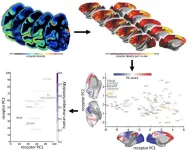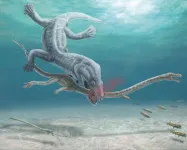(Press-News.org) Every day, tens of thousands of songs are released. This constant stream of options makes it difficult for streaming services and radio stations to choose which songs to add to playlists. To find the ones that will resonate with a large audience, these services have used human listeners and artificial intelligence. This approach, however, lingering at a 50% accuracy rate, does not reliably predict if songs will become hits.
Now, researchers in the US have used a comprehensive machine learning technique applied to brain responses and were able to predict hit songs with 97% accuracy.
“By applying machine learning to neurophysiologic data, we could almost perfectly identify hit songs,” said Paul Zak, a professor at Claremont Graduate University and senior author of the study published in Frontiers in Artificial Intelligence. “That the neural activity of 33 people can predict if millions of others listened to new songs is quite amazing. Nothing close to this accuracy has ever been shown before.”
Machine learning with neurologic data
Study participants were equipped with off-the-shelf sensors, listened to a set of 24 songs, and were asked about their preferences and some demographic data. During the experiment, the scientists measured participants’ neurophysiologic responses to the songs. “The brain signals we’ve collected reflect activity of a brain network associated with mood and energy levels,” Zak said. This allowed the researchers to predict market outcomes, including the number of streams of a song – based on the data of few.
This approach is called ‘neuroforecasting.’ It captures neural activity from a small group of people to predict population-level effects without having to measure the brain activity of hundreds of people.
After data collection, the researchers used different statistical approaches to assess the predictive accuracy of neurophysiological variables. This allowed for direct comparison of the models. To improve predictive accuracy, they trained a ML model that tested different algorithms to arrive at the highest prediction outcomes.
They found that a linear statistical model identified hit songs at a success rate of 69%. When they applied machine learning to the data they collected, the rate of correctly identified hit songs jumped to 97%. They also applied machine learning to the neural responses to the first minute of the songs. In this case, hits were correctly identified with a success rate of 82%.
“This means that streaming services can readily identify new songs that are likely to be hits for people’s playlists more efficiently, making the streaming services’ jobs easier and delighting listeners,” Zak explained.
Methods for replication
“If in the future wearable neuroscience technologies, like the ones we used for this study, become commonplace, the right entertainment could be sent to audiences based on their neurophysiology. Instead of being offered hundreds of choices, they might be given just two or three, making it easier and faster for them to choose music that they will enjoy,” Zak said.
Despite the near-perfect prediction results of his team, the researchers pointed to some limitations. For example, they used relatively few songs in their analysis. Furthermore, the demographics of the study participants were moderately diverse, but did not include members of certain ethnic and age groups.
Nevertheless, the researchers expect that their approach can likely be used beyond hit song identification, in part due to its easy implementation. “Our key contribution is the methodology. It is likely that this approach can be used to predict hits for many other kinds of entertainment too, including movies and TV shows,” Zak concluded.
END
Machine learning helps researchers identify hit songs with 97% accuracy
Scientists showed that applying machine learning to neural data leads to almost perfect classification accuracy for songs that may become hits
2023-06-20
ELSE PRESS RELEASES FROM THIS DATE:
Completing genome of rusty patched bumble bee may offer new approach to saving endangered bee
2023-06-20
LOGAN, Utah, June 20, 2023 — A detailed, high-resolution map of the rusty patched bumble bee’s genome has been released by U.S. Department of Agriculture (USDA) Agricultural Research Service (ARS) and U.S. Fish and Wildlife Service (USFWS) scientists, offering new possible approaches for bringing the native pollinator back from the danger of extinction.
Putting together the rusty patched bumble bee genome is part of the Beenome 100 project, a first-of-its-kind effort to create a library of high-quality, ...
Face of Anglo-Saxon teen VIP revealed with new evidence about her life
2023-06-20
The face of a 16-year-old woman buried near Cambridge (UK) in the 7th century with an incredibly rare gold and garnet cross (the ‘Trumpington Cross’) has been reconstructed following analysis of her skull. The striking image is going on public display for the first time on 21st June, with new scientific evidence showing that she moved to England from Central Europe as a young girl, leading to an intriguing change in her diet.
The image and artefacts from the mysterious woman’s ...
Weak policies and political ideologies risk jeopardizing plans to tackle health and climate change, says Cambridge expert
2023-06-20
Weak policies and political ideologies risk jeopardising plans to tackle health and climate change, says Cambridge expert
Efforts to tackle major issues facing the UK, including the nation’s health and climate change, are being hampered because politicians often ignore the existing evidence when setting policies, according to Dame Theresa Marteau, a public health expert at the University of Cambridge.
Writing in the journal Science and Public Policy, Professor Marteau argues that this ‘evidence-neglect’ is a result of incentive structures that encourage politicians to set ambitious policy goals while simultaneously disincentivising ...
Low-dose aspirin use associated with 20% increased anemia risk in older adults
2023-06-19
1. Low-dose aspirin use associated with 20% increased anemia risk in older adults
Abstract: https://www.acpjournals.org/doi/10.7326/M23-0675
URL goes live when the embargo lifts
An analysis of the ASPREE (ASPirin in Reducing Events in the Elderly) trial found that the use of low-dose aspirin was associated with a 20 percent increased incidence of anemia and decline in ferritin, or blood iron levels, in otherwise healthy older adults. These findings suggest that periodic monitoring of hemoglobin should be considered in older patients taking aspirin. The analysis is published in Annals ...
Chinese paleogeneticist FU Qiaomei awarded UNESCO–AI Fozan International Prize for the Promotion of Young Scientists
2023-06-19
FU Qiaomei, a paleogeneticist at the Chinese Academy of Sciences (CAS), received the UNESCO–AI Fozan International Prize for the Promotion of Young Scientists in Science, Technology, Engineering and Mathematics (STEM) on June 19 in Paris, France, for her “seminal work on the history of early humans in Eurasia, based on genetic lineage studies, which provides new insights on the early human history of Eurasia and perspectives on the evolution of human health.”
She was one of five young scientists from around the world to receive the prize, alongside researchers from Argentina, Cameroon, Egypt, and Serbia. The laureates were ...
Clean, sustainable fuels made ‘from thin air’ and plastic waste
2023-06-19
Researchers have demonstrated how carbon dioxide can be captured from industrial processes – or even directly from the air – and transformed into clean, sustainable fuels using just the energy from the Sun.
The researchers, from the University of Cambridge, developed a solar-powered reactor that converts captured CO2 and plastic waste into sustainable fuels and other valuable chemical products. In tests, CO2 was converted into syngas, a key building block for sustainable liquid fuels, and plastic bottles were converted into glycolic acid, which is widely used in the cosmetics industry.
Unlike earlier tests ...
Human Brain Project study offers insights into neuroreceptor organization
2023-06-19
A key challenge in neuroscience is to understand how the brain can adapt to a changing world, even with a relatively static anatomy. The way the brain’s areas are structurally and functionally related to each other – its connectivity – is a key component. In order to explain its dynamics and functions, we also need to add another piece to the puzzle: receptors. Now, a new mapping by Human Brain Project (HBP) researchers from the Forschungszentrum Jülich (Germany) and Heinrich-Heine-University Düsseldorf (Germany), in collaboration with scientists from the University of Bristol (UK), ...
These long-necked reptiles were decapitated by their predators, fossil evidence confirms
2023-06-19
In the age of dinosaurs, many marine reptiles had extremely long necks compared to reptiles today. While it was clearly a successful evolutionary strategy, paleontologists have long suspected that their long-necked bodies made them vulnerable to predators. Now, after almost 200 years of continued research, direct fossil evidence confirms this scenario for the first time in the most graphic way imaginable.
Researchers reporting in the journal Current Biology on June 19 studied the unusual necks of two Triassic ...
Brain receptor patterns separate sensory and cognitive networks, new study finds
2023-06-19
Receptor patterns define key organisational principles in the brain, scientists have discovered.
An international team of researchers, studying macaque brains, have mapped out neurotransmitter receptors, revealing a potential role in distinguishing internal thoughts and emotions from those generated by external influences.
The comprehensive dataset has been made publicly available, serving as a bridge linking different scales of neuroscience - from the microscopic to the whole brain.
Lead author Sean Froudist-Walsh, ...
A new tool to study complex genome interactions
2023-06-19
People who owned black-and-white television sets until the 1980s didn’t know what they were missing until they got a color TV. A similar switch could happen in the world of genomics as researchers at the Berlin Institute of Medical Systems Biology of the Max Delbrück Center (MDC-BIMSB) have developed a technique called Genome Architecture Mapping (“GAM”) to peer into the genome and see it in glorious technicolor. GAM reveals information about the genome’s spatial architecture that is invisible to scientists using solely Hi-C, a workhorse tool developed in 2009 to study DNA interactions, reports a new study in Nature Methods by the Pombo lab.
“With ...
LAST 30 PRESS RELEASES:
Researchers identify gene that calms the mind and improves attention in mice
Artificial metabolism turns waste CO2 into useful chemicals
Ancient sea anemone sheds light on animal cell type evolution
Begging gene leads to drone food
How climate policies that incentivize and penalize can drive the clean energy transition
Can community awareness campaigns in low-resource areas improve early diagnosis of colorectal cancer?
Stardust study resets how life’s atoms spread through space
Practical education: Clinical scenario-based program development
The impact of family dynamics on eating behaviour – how going home for Christmas can change how you eat
Tracing the quick synthesis of an industrially important catalyst
New software sheds light on cancer’s hidden genetic networks
UT Health San Antonio awarded $3 million in CPRIT grants to bolster cancer research and prevention efforts in South Texas
Third symposium spotlights global challenge of new contaminants in China’s fight against pollution
From straw to soil harmony: International team reveals how biochar supercharges carbon-smart farming
Myeloma: How AI is redrawing the map of cancer care
Manhattan E. Charurat, Ph.D., MHS invested as the Homer and Martha Gudelsky Distinguished Professor in Medicine at the University of Maryland School of Medicine
Insilico Medicine’s Pharma.AI Q4 Winter Launch Recap: Revolutionizing drug discovery with cutting-edge AI innovations, accelerating the path to pharmaceutical superintelligence
Nanoplastics have diet-dependent impacts on digestive system health
Brain neuron death occurs throughout life and increases with age, a natural human protein drug may halt neuron death in Alzheimer’s disease
SPIE and CLP announce the recipients of the 2025 Advanced Photonics Young Innovator Award
Lessons from the Caldor Fire’s Christmas Valley ‘Miracle’
Ant societies rose by trading individual protection for collective power
Research reveals how ancient viral DNA shapes early embryonic development
A molecular gatekeeper that controls protein synthesis
New ‘cloaking device’ concept to shield sensitive tech from magnetic fields
Researchers show impact of mountain building and climate change on alpine biodiversity
Study models the transition from Neanderthals to modern humans in Europe
University of Phoenix College of Doctoral Studies releases white paper on AI-driven skilling to reduce burnout and restore worker autonomy
AIs fail at the game of visual “telephone”
The levers for a sustainable food system
[Press-News.org] Machine learning helps researchers identify hit songs with 97% accuracyScientists showed that applying machine learning to neural data leads to almost perfect classification accuracy for songs that may become hits






